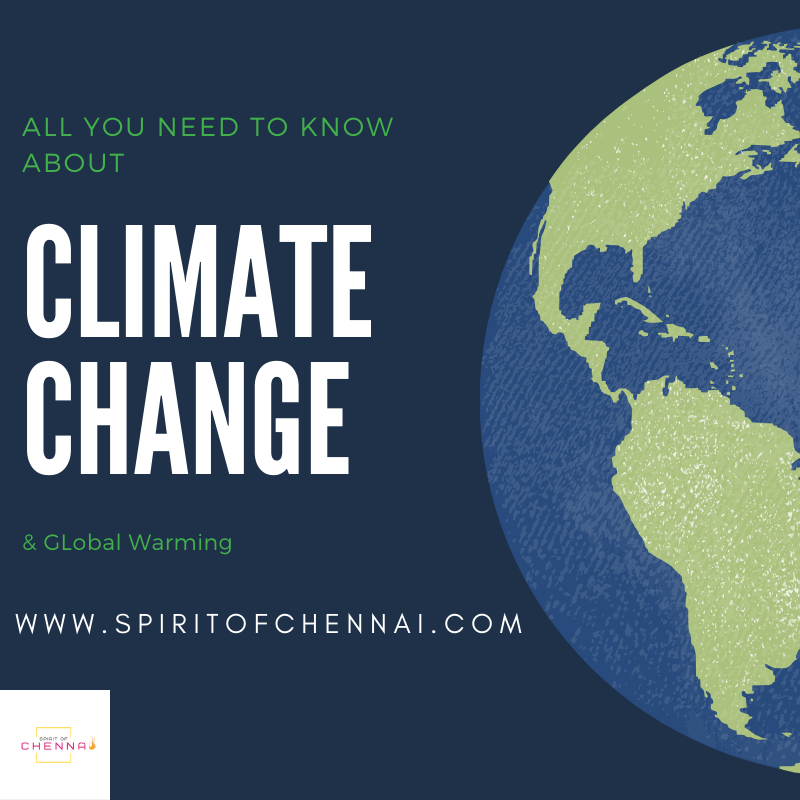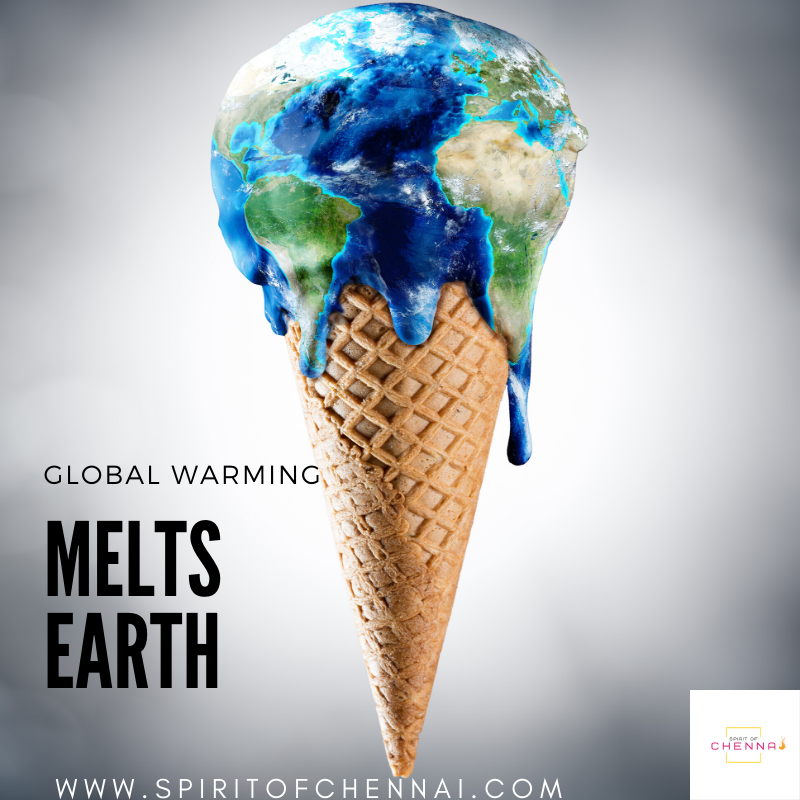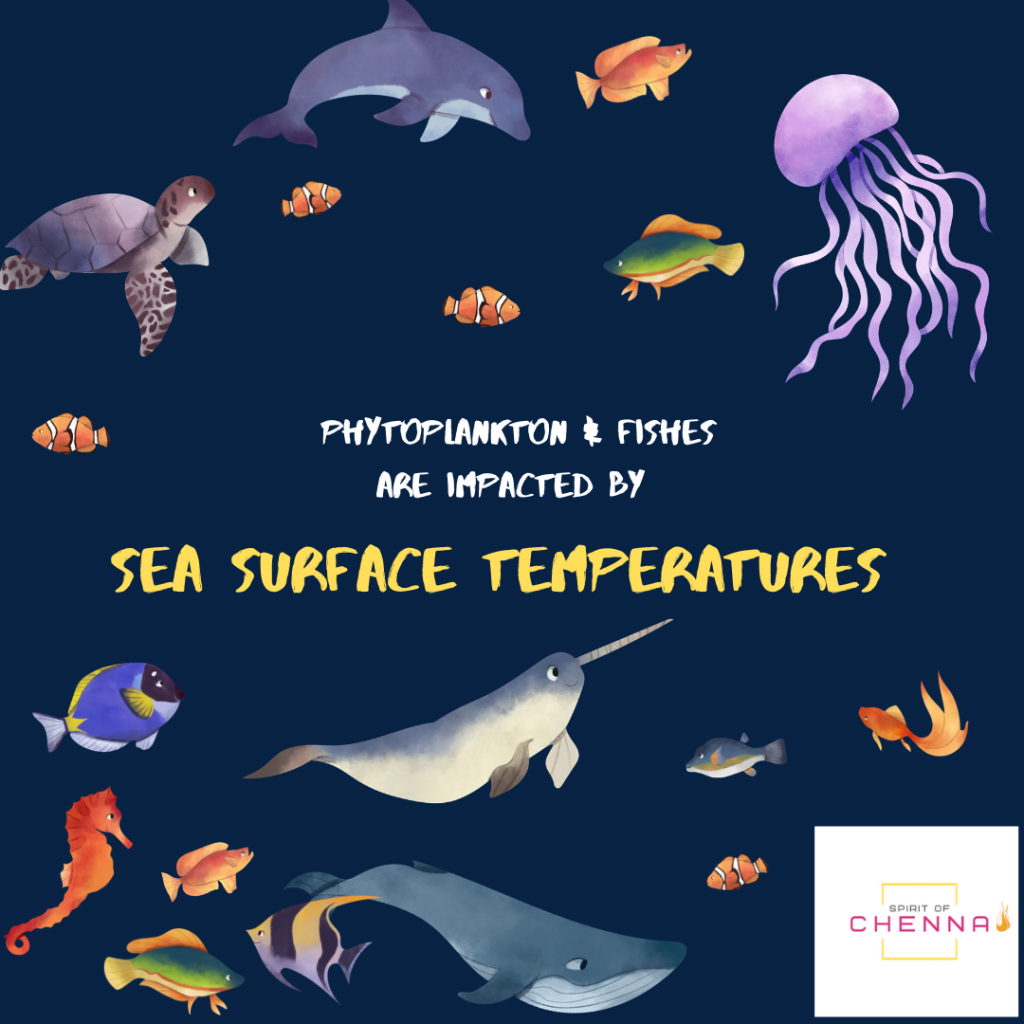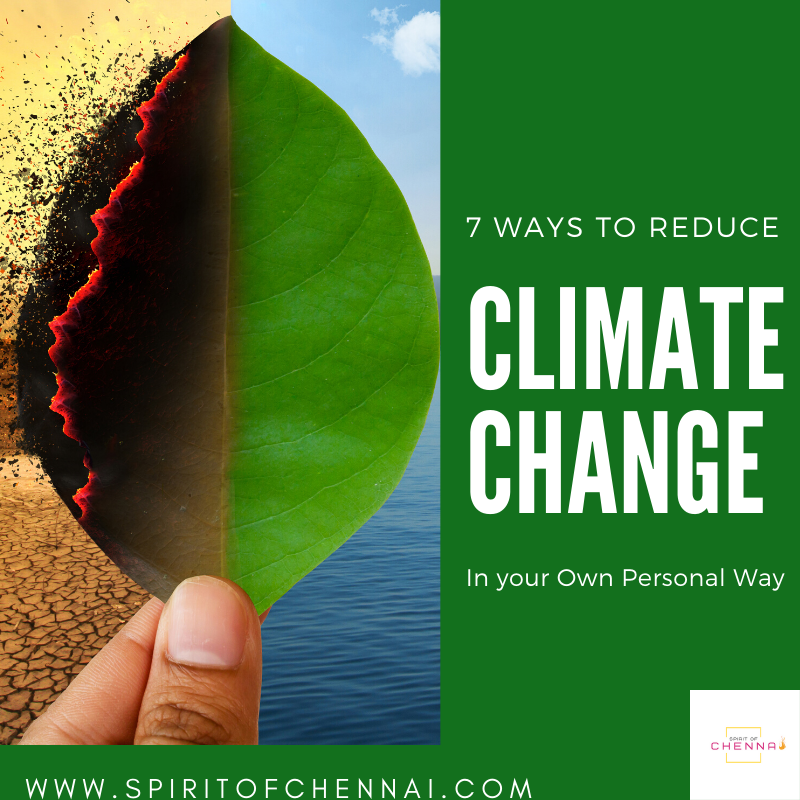Climate Change & Global Warming – The Ultimate Lecture, is a holistic content aspiring to make readers acquaint with the Definition, Facts, Causes, Effects and Prevention of Climate Change. The article uses Chennai Climate Change Impacts as examples to illustrate the Subject Concept.

Why Chennai Climate Change was Selected to illustrate?
Chennai has become the poster boy for Climate Change.
Water Crisis, Drought, No Rains, Excessive Rains, Floods, Cyclones, Sea Water Rage, and Ground Water Contamination – If there are multi-faceted nature related problems a City is facing it would be in Chennai.
Chennai Weather and overall climate has off late become a puzzle, even to the most brilliant experts in the field.
While Rain and Weather predictions for short-term forecasting have been fairly accurate, it has become increasingly become a challenge to predict medium-to-long term weather events. For example, you should have noticed a trend as to how the Rains Predicted for Next 24 Hours by experts will be accurate but Forecasts for anything between 48 hours to 3 days will be grossly wrong! In most cases, rain forecasts predicted over 2-3 days results in a bright and shiny Day, with not a drop of drizzle!
- Why is it becoming a challenge to predict weather?
- Why is it that extreme Climate events are happening in Chennai?
- Why it is either there is No Water or too much Floods?
The answer is Climate Change!
Before we get to talk about Climate Change in Chennai we need to understand the geography of Climate, Weather and Climate Change.
Climate Change is no longer a subject domain of an expert scientist or organization. It’s is an everyday problem affecting a common man!
It is important we understand the details of climate change, for us to take actionable changes to our way of living.
We CANNOT reverse Climate Change! But together we can fight its Impacts!
Weather and Climate – The Difference
Climate and weather are not the same.
Weather is a short term event. It is a Day-to-Day Predicted of the regional atmosphere. Elements like temperate, rainfall and wind patterns are predicted on a DAILY BASIS. Weather can also be precisely predicted for up to a Week. For example, today’s Rain forecast, Tomorrow’s Temperature, Today’s Humidity, ,…..
What is Climate?
Climate is a long-term event. Usually 3 months Period.
A group of predicted historical weather events repeated over a span of twenty to hundred years show some characteristic trend of the weather patterns. For Example, the Temperature is usually high between January to May in India, EACH YEAR. Rain (South-West Monsoon) is forecast between June – October, EACH YEAR.So are other weather events which have been showing a historical trend of repeating each year. These are grouped to be climate of the region! Climate is most described as summer, monsoonal and winter…
These are nothing but the grouped weather aggregates over that specific period. It becomes easier to predict the future climate of the region when the historical weather metrics of aggregated. It becomes easier characterize the climatic type of the region based on these climatic patterns or trends.
Climate Types
World Regions can be categorized into five macro climate Types. We need to rely on globally accepted classification system to understand climate type – hence, Koppen Climate Classification is being explained.
The Globe can be classified into Four Zones based on it’s position in relevant to the Equator. The Tropical or Equatorial regions, which are on or very near to the imaginary equatorial line. Second, the sub-tropical regions, both on the north and the south, third the Temperate Zones and finally the polar frigid zones on both the North and the South Pole.
Each of these basic four zones have a characteristic climate type, particularly in the position near or far from the equator and the angle at which the sun’s rays hit the region. For example, Chennai enjoys a tropical hot climate, being close to the equatorial line, while Delhi has a Sub-tropical Climate with Hot Summers and Cold Winters, being a little further away from the equatorial line.
The above scenario of a region’s equatorial position was further analyzed with the Plants/Forest Types by Botanist Waldimir Koppen . After this research, he became the world’s most renowned Climatologist to have first summarized the World Climatic types, so much in Detail. According to him the climatic types are:
- Tropical or Megathermal climate (HOT Regions)
- Dry or Semi-arid Climate (Desert Regions)
- Temperate or Mesothermal Climate (Not so hot Mediterranean regions)
- Continental or Microthermal Climate (Sub-polar regions, where it is cold but still habitable by humans).
- Frigid or Polar Climate (Polar regions that are extremely cold and are not habitable by humans)
Now, each of the climate types has a significant characteristic, especially in their response to climate Change Impacts.
While, Climate Change triggered by Global Warming can melt the thick ice glaciers of Polar Climate Types, it may lead to secondary impacts like sea level rise in sub-tropical to tropical climatic zones.
We will cover in detail about the overall impacts of climate change in this section as well.
Climate Variability and Climate Change – The Difference
The Climate of the region (though based on individual historic weather values) may not be same all the time. It may show some change either to being a little extra or a little less. For Example, Chennai’s highest average summer temperature over twenty years was 39°C. However, in the recent 3-5 years Chennai has seen scorching hot days touching 41°C – if 43°C. These values are high, but acceptable high that is near the historical average value. This is Climate Variability!
When the Weather Values are below or above the acceptable range of historical Weather Values (aggregated as climatic trend) then it is termed as Climate Variability.
What is Climate Change?
Climate Change are Extreme Weather events which has not happened in the past and that was not predicted to happen.
It is more along the lines of disaster, which happens all of a sudden and furious.
For Example, Chennai usually receives rains from North-East Monsoons, with the highest year-on-Year average intensity between 26 mm to 50 mm – in Rain Category of Scattered and Isolated places. The Average Wind Speed of these rains in Chennai had been 8.990259 km/h. However, December of 2016 the rainfall depression turned to be a very severe cyclonic storm called the Varda Cyclone with an average wind speed of 105 km/h in Chennai. Now, compare these two values. The normal accepted rainfall wind speed value of Chennai is 8.990259 km/h. But, 2016 values were 105 km/h.
Do you see, the 2016 values are way beyond extreme accepted range of average acceptable values?
This is a disaster event and an impact of Climate Change.
Climate Change definition
United Nation Framework Convention on Climate (UNFCC) is the scientific official body of all climate policies of the world. Hence, their definition of Climate Change should the most technically accurate and globally accepted statement for us to quote.
“Climate change means a change of climate which is attributed directly or indirectly to human activity that alters the composition of the global atmosphere and which is in addition to natural climate variability observed over comparable time periods “
What are the effects of Climate Change?
Climate Change does not have effects. It is the effect!
Climate Change is the end result of manifestation of various natural and man-made disasters. While, natural disaster is a sudden unexpected event, a disaster which occurs as a result of another geographic causative trigger can be categorically grouped under effects of climate change.
Over 70% of the world is beginning to realize the effects of Climate Change. Chennai is no way an exception! Chennai is and will have greater disastrous Climate effects.
Unless, we work together to minimize the scale of disaster nothing stops the impending boisterous end!
Climate Change effects in Chennai:
More Scientific Research Summaries are provided as Impacts Climate Change in Chennai . However, in the interest of understanding the concepts of effects or end results of climate change, I have provided the following scenario when Chennai Snowed in 1815!
Did you know about Chennai Snow?
A City that enjoys tropical hot temperatures throughout the year, once had a freezing temperature window of 3°C. This freezing temperature was not a historical climate scenario but a short-term climate change effect caused by a natural disaster in Indonesia.
The Chennai Snow Reason was the Volcanic Eruption of Mount Tambora in Indonesia on April 10 – 11, 1815. Recorded as one of the largest volcanic eruption in the history of disaster (even as of today), the volcano spewed fumes, hot lava and ash dust into the atmosphere. The volume of the volcanic ash was so high the layer of ash covered the global atmosphere as if it were a huge blanket net covering the aerial troposphere of the world regions. Neighboring Countries like India had an even thicker denser ash cover over its atmosphere.
What do you think will happen if your outdoor were covered to atmospheric ash instead of bright and shiny clouds?
You guessed it right. Sunlight will not be able to freely penetrate into the Land.
This is the reason for Chennai Snow. Not Just Chennai. Many parts of the world was a “World without Summer” until the year 1816, because of the climate change effect caused by Indonesian Volcanic Eruption.
It is important to know the History. Because History Repeats, and if we know how the problem was overcome yesterday, we will at least be able to manage it better in the future!
Before I get to talk about Climate Change Effects in Chennai with greater depth, there are few more fundamental concepts that climate Change story demands a reader to be familiarized with. One of them is Global Warming.
Global Warming – Definition
The Official Source of all Climate Change Definitions would be IPCC.
According to IPCC:
“Global warming is defined in this report as an increase in combined surface air and sea surface temperatures averaged over the globe and over a 30-year period.
Unless otherwise specified, warming is expressed relative to the period 1850–1900, used as an approximation of pre-industrial temperatures in AR5. For periods shorter than 30 years, warming refers to the estimated average temperature over the 30 years centred on that shorter period, accounting for the impact of any temperature fluctuations or trend within those 30 years.”

What is Global Warming?
Global Warming is the average increase of global atmospheric temperatures. This increase in temperature is primarily attributed to the Five Green House Gases
Carbon-Di-Oxide (Co2)Methane (CH4), Sodium-Di-Oxide (SO2), Nitrous-Di-Oxide (NO2) and F-Gases (HFC, Fluro Carbons...).
Before, you think to discount this section of greenhouse gases chemical composition as a subject reserved for scientists, please do be aware a lot of these gases end up in the atmosphere because of us.
Solely Us!
Green House Gases names and how we contribute them?
Carbon-Di-Oxide (CO2) ends up in the atmosphere because of our increased Electricity usage, vehicular overuse (Each one drives a car, don’t we) and burning of agricultural or garbage waste.
Methane (CH4) ends up in the atmosphere because of voluminous Solid Waste dumped in our neighborhood and city dumpyard, Excessive Plastic Waste disposals, Animal Husbandry or Animal Farms reared for Milk Products and Excessive Fossil Fuel Combustion (Petrol and Diesel Use)
Sodium-Di-Oxide (SO2) which is supposed to be spewed into the atmosphere by Volcanic Ash (Naturally), is now increasingly contributed by our human activities like fossil fuel combustion (Petrol and Diesel overuse), Mineral Industries (Aluminum, Iron, Copper products we use),..
Nitrous-Di-Oxide (NO2) is contributed to the atmosphere by fossil fuel combustion (Increased use of Petrol and Diesel Use). Car Emissions are a major source of both SO2 and NO2.
Do you see how our everyday activities are causing increase in atmospheric Green House Gases to thereby cause Global Warming and eventually trigger a climate change event?
Though at an individual scale it’s might just be another one in a million electric light burning in your bed room, a lonely car drive to work or plastic overuse, know that each of this aggregate to cause a macro level impact called Climate Change.
Global Warming and Climate Change
Global Warming and Climate Change have become increasing inter-related terms of 21st century. Mostly because, Global Warming is one of the primary reason of Climate Change effects across the world.
Global Warming Causes Climate Change
To Understand how global warming causes world Climate Change it is important to understand the effects of Global Warming.
Effects of global warming
Global Warming causes two major effects.
- Increase in Land Surface Temperature (LST)
- Increase in Sea Surface Temperature (SST)
These two impacts of global warming are just the tip of the iceberg. Individually, each of these two effects has the potential to create secondary cascading impacts that will eventually destroy our world!
Effects of Climate Change via Increased Land Surface Temperature (LST)
Increase in Land Surface Temperature (LST), increases the regional (our City’s) atmospheric temperature by few Degree Celsius or Fahrenheit.
This increase in Land Surface Temperature (LST) induces
- Increased Water Evaporation, which causes drying up of wells, reservoirs, Ponds, and Waterbodies, thereby triggering Water Crisis Situation called Drought for the City.
Remember, the Chennai Water Crisis 2019?
While, the reason can partially be attributed to building encroachments over waterbodies, Impacts of Climate Change and increased Water Evaporation due to Global Warming is also a causative factor that caused the lakes to dry!
2. Reduced Agricultural Productivity, for all the Crops, needs the right proportion of temperature and water for successful harvests. An increase in temperature incinerates the plant tissues. Added to it the reduced soil water levels (lost due to water evaporation) greatly reduces the Agricultural Productivity of the land.
Imagine a World without Rice, Wheat or Onions – It would be an obvious result of Global Warming, not just Economics or governance
3. Public Health Problems, where large scale incidents of Heat Strokes, Cardiac Arrest, Dizziness, Skin Problems, and Respiratory illness will be evident.
More susceptible Age Groups of Climate Change Health Impacts are Children (below 10 years) and Senior Citizens (Over 60 Years).
An increase in CO2 levels (a Green House Gas) is directly responsible for all the respiratory, Lung and Asthma problems the world is facing today.
4. Reduced Green Cover, Deforestation is another result of increased Land Surface Temperature. Though not an immediate result of Global Warming, it is slow and irreversible damage that impacts the climate of a region.
According to a World Bank Report, the global forest cover was reduced by 502,000 square miles (1.3 million square kilometers). 46% of the world’s trees have been deforested for Agricultural and Economic Development. The rate of deforestation has accelerated in 2019 due to the Amazon Forest Fire.
Trees not only provide us with Oxygen, but they also absorb atmospheric Carbon-dioxide. So felling trees not only reduces our outdoor oxygen levels, but it also increases the atmospheric Carbon-Di-Oxide levels. Toxic, harmful CO2 Levels!
Now, no amount of development is going to sustain mankind if we lack Oxygen to Breathe!
Deforestation directly aggravates Global Warming and accelerates Climate Change. And it is Irreversible!
Effects of Climate Change Via Increased Sea Surface Temperature (LST)
70% of our world waters are impacted due to Global Warming. 30% of the landmass (or Cities) receives the burnt of the impact.
The Increase in Temperature of Oceans causes
- Ice Glaciers to Melt: The Polar Ice Sheets when it melts liquidates into the water, thereby increasing the seawater levels. The Increase in Sea Water Levels will be at the cost of Landmass Subduction. A 3 Meter Rise of Bay Of Bengal Seas has the potential to submerge the entire Chennai City. The World Coastal Regions are at direct threat to be submerged if ice sheets continue to retreat.
Climate Crisis caused by Melting Glaciers will caused Coastal Flooding and Land Mass Submergence.
- Ground Water Contamination: The Increase in seawater temperatures, make the sea dissipates its salt content into landmass. Salt Water Intrusion into Ground Water Borewells is already a reality in cities like Chennai. East Coast Road (ECR), Old Mahabalipuram Road (OMR), Velachery, Perungudi, Pallikarnai are few locations in Chennai that have the worst groundwater quality. Global Warming Impact may pose a threat to the world underground aquifer systems, which will threaten both our drinking water supplies and Human Health indices.
- Sea Water Currents: There is a Global Energy Balance called Entropy the regulates the Atmospheric Wind/Pressure Circulation and Climates. An Increase in Temperature on Sea Water will increase the density of Warm Water Currents over Cold Water Currents. This directly impacts the Climatic Variables of the region. Some locations, receive both Flood and Drought. Rains are very uneven and cannot be predicted using long-term models. There are Tornadoes, Typhoons and Sea-Floor Earthquakes on the other side. These extreme climatic events which devastate a city can be attributed to the impact of Global Warming on Sea Water Currents. Another aspect of unbalanced Sea Water Currents is the life of marine eco-systems. Aquatic Plants and Marine Animals, fishes are largely affected due to the increased temperatures.

Can we Reduce Climate Change Effects?
The answer is a Simple No!
We have together pushed the extremes of our universe and there is little we can now (2019) do to reverse Climate Change.
But, We can Prepare.
Prepare to delay the impacts by adopting the Climate Action Plans recommended by IPCC.
How to Solve Climate Change problem?
Climate Change problems may not be solved, but minimized. There are two ways to solve the issues of climate change.
- One at a National Government Scale
- Second at an Individual Person Level.
At a National Government Scale, Climate Action Plans are recommended to minimize Country-Level Global Warming Emissions.
At an Individual Person Level, certain small lifestyle changes when adopted can together address the climate change issues.
What are Climate Action Plans?
Climate Action Plans are Country Level Actionable reforms, which when practiced individually by every world city, can reduce the Climate Crisis by a few years. The World Governments at a National Level commit to the global councils to keep their National Green House Emission Levels in Check!
Four Sectors are Monitored by the National Government to honor global Commitments. They are
- Transportation-related Green House Emissions
- Energy or Electricity-related Green House Emissions
- Municipal Solid Waste-related Green House Emissions
- Agriculture-related Green House Emissions
Some Governments also commit to monitoring the Concrete Buildings levels (in Urban Metropolitan), to keep their greenhouse emission levels in check.
How to Prevent Climate Change at Individual Level?
At an individual level, we can be the change that we wish to see. Though at a macro level governments commit to climate action plans, what we do at an individual level makes a lot of difference in delay the impacts of global warming.
By now, you should have realized the increase in Global Warming Causes Climate Change! What we do in our homes affects the earth. Together, we can adopt a few lifestyle changes that will contribute to the overall lifetime of mother earth.
Seven Ways to Reduce Climate Change:
- Increase In-House Renewable Energy Circuits: We cannot wholly get away from using electricity. But, few of our high power consumption appliances can be powered by renewable energies can Solar Powers Panels. At a Resident Welfare or Community Association Level, we can adapt to cultivate Solar Powered Street Lights, Geo-Thermal Heat Energy to Heat Buildings (In Cold Countries),…
- Reduce Air Cooler & Air Conditioning: In a tropical city like Chennai, it is impossible to live without AC. But, high usage of AC not only dents your bank credits but also increases greenhouse gas emissions into the atmosphere. Alternatives, to AC, will be keeping your room well ventilated with Natural Air and usage of Organic Cotton Mosquito Nets during Nights. Traditionally, most of our Indian Homes were built with good natural ventilation. Our ancestral homes had higher roof heights, thereby making the hot warm air to go up and relatively cold air to come down. These days, in the interest of FSI or Cost Savings most of our Apartments are built with almost no roof heights. It is vital to re-structure our homes (Individual Houses) to cultivate our ancestral best practices. They not only improve our Health, Longevity, and Finances but also reduces Global Warming.
- Use Public Transport: Using Public Transport can put you on ease to reach your destination safely, comfortably and economically. People who shifted to using city buses not only reported better sanity levels by not having to deal with the stress of driving in chaotic urban traffic but also reported huge savings in fuel costs. Using Public Transport can greatly reduce the aggregated Fossil Fuel Emission, that all our city cars are contributing to the atmosphere. Adopting to Energy-efficient Electric Buses can even further reduce our carbon footprint.
- Cycle A Lot: Riding a bicycle to near-by places can greatly reduce carbon emissions. Limiting Two-wheeler or Car usage to long-drives only can reduce your fuel emission contributions to the atmosphere. Bicycling also comes with a ton of health benefits and needless to say money savings in terms of eliminating fuel costs.
- Eat Less Meat or Go Vegetarian: Animal Husbandry is the Second largest contributor of Atmospheric Methane. By, reducing the intake of animal Meat, you not only reduce global warming but also give animals a chance to live! Going vegetarian also comes with health benefits!
- Recycle-Reuse: Solid Waste is the First Largest Contributor to Methane. A Simple Waste Segregation at your home can help the community recycle and reuse Garbage. There are Treasures in Garbage! Organic Vegetable Waste when segregated and composted can be used to manure plants.
- Grow Plants: Urban Forestry is now a vogue. Grow your own Oxygen has now become an trend. It is vital to grow plants at your home. Growing Plants around your homes improves your in-door air quality, supplies your very own fresh oxygen supply and contributes to your neighborhood’s Green Cover. In a way, you are performing the act of Afforestation at small scale. It is those small seeds that your plant in your homes, that has the power to sustain your neighborhood ecology. So, go ahead and plants those seeds that can fight climate change.

Conclusion of Global Warming and Climate Change:
Climate Change is Real.
Global Warming Accelerates Climate Change Effects.
Green House Gases are Killing Our Health and Atmosphere.
It is too late to reverse Climate Change.
But, yes. We still can do something about it to delay climate disasters from affecting us.
Together We can build communities to increase awareness.
Together we can adopt Climate Action Plans.
Together we can change to minimalistic go-green lifestyles.
Together we can reduce the Effects of Climate Change.
Write to beulah.evelyn.lazrus@gmail.com to know more about this topic or get help in promoting Climate Awareness in your community.



